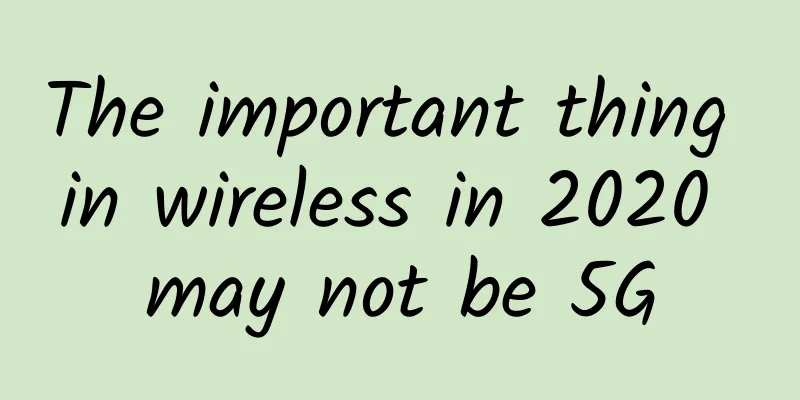Six major trends in 5G development in 2021

|
2020-12-31 09:392020 is a year of vigorous construction and accelerated development of 5G networks. According to GSA statistics, as of mid-December 2020, 135 operators in 58 countries around the world have built 5G commercial networks, which is nearly double the number of operators that launched 5G commercial networks in February 2020. Driven by the wave of "new infrastructure", my country's 5G network construction has been completed beyond expectations. So far, my country has built more than 700,000 5G base stations, covering all cities above the prefecture level in the country. The rapid development of 5G networks has driven the improvement of 5G terminals and the improvement of the industrial integration application ecosystem. As 5G empowers more vertical industries, the diversified and differentiated vertical industry integration application needs in turn promote the evolution and development of 5G network technology. Looking at all aspects of 5G networks, terminals, services, etc., the development of 5G in 2021 will show the following trends. 5G networks continue to develop steadily and rapidly In 2020, 5G has become an important part of my country's "new infrastructure" strategy. As the key to "new infrastructure", 5G network has been repeatedly mentioned to accelerate the development of 5G. Driven by the "new infrastructure", my country's 5G network has developed rapidly, and has driven the continuous expansion of the scale of the entire industry. The effect of my country's moderately advanced 5G network construction strategy has initially emerged. According to public data from the Ministry of Industry and Information Technology, as of the end of 2020, my country has built more than 700,000 5G base stations, and the number of 5G terminal connections in my country has exceeded 180 million. At the same time, the construction of 5G networks has also provided a solid foundation for the development of vertical industry integrated applications. 5G+smart factories, 5G+smart medical care, 5G+smart education and other integrated applications are emerging in an endless stream. It can be foreseen that in the next few years, toC applications with 5G characteristics will show a scale growth, and toB applications will gradually mature and gradually land for commercial use. This will put forward higher requirements for the coverage and performance of 5G networks. Based on the characteristics of moderately advanced public infrastructure, 5G network construction will continue to develop steadily and rapidly in the next three years, and the development momentum is strong. The 5G vertical industry integrated application ecosystem is accelerating construction and gradually being put into commercial use The development goal of 5G network is to realize the intelligent information connection between "people and people", "people and things", and "things and things". With the vigorous construction and development of 5G network in 2020, the industry application innovation is continuous. 5G has begun to empower thousands of industries such as industry, transportation, energy, medical care, and economic society, thereby promoting a new round of changes in production and lifestyle. In 2020, although 5G signals covered Mount Everest, making 5G the world's highest peak, and 5G vertical industry integration applications are emerging in an endless stream, it must be said that the current applications for public customers are more concentrated in ultra-high-definition video transmission, AR/VR, etc., and killer applications still need to be further explored. In addition, the business model of 5G integrated applications for industries still needs further research. Therefore, in the next few years, in order to give full play to the value of 5G, the industry will accelerate the construction of the 5G industry ecosystem, enrich and deepen the integration of 5G and vertical industries, and gradually promote the commercialization of 5G in industrial Internet, education, medical care, smart cities and other scales. 5G technology continues to evolve to meet the diverse application needs of vertical industries With the continuous improvement of 5G "new infrastructure", 5G networks have provided network support for various fields. Vertical industry applications have also put forward higher network capability requirements for 5G networks, requiring 5G technology to continue to evolve in order to maintain the advantages of technology industry support. Meeting large uplink demands - With the continuous improvement of 5G network construction and the increasing number of 5G applications, toB services such as high-definition monitoring have stronger demands for uplink rates. However, taking the current 3.5GHz frequency band and 100MHz bandwidth as an example, the 5G uplink peak rate is only 380Mbit/s, and the uplink rate is severely limited. It is urgent to improve the uplink service rate through 5G enhanced technologies such as uplink carrier aggregation, flexible frame structure configuration, and millimeter wave large bandwidth, so as to achieve uplink gigabit network capabilities and meet the large uplink demands of vertical industries. Meeting low latency requirements - With the integration of 5G and vertical industry applications, the characteristics of 5G vertical business applications, especially the network latency requirements and network capability requirements, are significantly differentiated. Therefore, the network latency experience will become an important aspect affecting the profitability of operators' networks. It is necessary to introduce technologies such as uRLLC to empower the diverse services of public and industry users, while meeting low latency and creating ultimate network capabilities that are scalable, manageable and controllable. Meeting the demand for large indoor capacity - With the development of 5G networks, indoor services will show explosive growth. It is predicted that more than 80% of services will occur indoors in the future, and the demand for indoor capacity will further increase. The traditional capacity expansion method is achieved by splitting the cells between different indoor micro-stations. Under dense indoor networking, serious interference between cells will occur, which will greatly reduce the capacity expansion effect and affect the evolution of indoor capacity. It is necessary to consider 5G enhanced technologies such as distributed Massive MIMO or millimeter wave to achieve an elastic leap in indoor capacity, thereby bringing better business experience to toC users and providing a better network for the toB industry. 5G pan-terminals are fully developed with lower costs With the construction of 5G in full swing, the categories and forms of 5G terminals are also gradually enriched. According to GSA statistics, as of the end of November 2020, there were 303 5G commercial terminals in the world, including 205 smartphones, 34 5G CPEs, 23 5G modules, 16 5G mobile hotspots, and 6 5G tablets. In addition, more 5G terminal types such as drones, head-mounted displays, robots, TVs, USB network cards/modems/adapters and vending machines are also emerging. With the development of 5G modules towards universalization and modularization, 5G pan-terminals will surely accelerate and develop in an all-round way. In addition, according to statistics from the China Academy of Information and Communications Technology, the domestic market shipments of 5G mobile phones in November 2020 have reached 20.136 million units, an increase of nearly 3 times from the beginning of the year. The price of 5G terminals has also dropped significantly from the beginning of the year. In the next few years, with the comprehensive development and scale of 5G pan-terminals, the price of 5G terminals will inevitably drop further. 5G cloud-network-edge-end-industry integration deepens With the continuous improvement of 5G networks, 5G has expanded from serving individual public users to serving thousands of industries. The deepening of 5G empowerment of vertical industry digital transformation will inevitably require 5G networks to carry more vertical industry needs. Cloud-network integration combines 5G networks with cloud service capabilities, and can rely on 5G's large bandwidth, low latency, and wide connection access capabilities to meet the flexible configuration of different applications of industry customers in various fields. Cloud-network integration is the general direction of the in-depth transformation of the telecommunications industry. At the same time, in order to meet the more personalized and fragmented needs of vertical industries, as well as higher real-time requirements, edge computing technology is also indispensable. Therefore, the future 5G network will inevitably deepen the integration of cloud-network-edge-end-industry, so as to better balance the needs of toC and toB users, and achieve the upgrade from meeting public consumer services to industrial empowerment, help industry application transformation and upgrading, and accelerate the digitalization process of traditional industries. 5G co-construction and sharing will gradually form a demonstration With the help of "new infrastructure", 5G network, as an important part of the network power and digital China, will be further strengthened and accelerated. Coupled with the continuous deepening of the work of "speeding up and reducing fees", 5G co-construction and sharing has become an important means to improve the asset operation efficiency of operators and achieve mutual benefit and win-win results in a more intensive and efficient manner. At present, my country has co-built and shared more than 300,000 5G base stations. The subsequent co-construction and sharing of 5G networks will also go deeper and may even expand to more resource elements (such as cloud resources). 5G co-construction and sharing will also form a demonstration and benchmark, thereby releasing more dividends to the industry, contributing valuable solutions to the development of the digital economy, and providing the world with the "Chinese experience" and "Chinese solution" for 5G construction. Of course, with the development of co-construction and sharing, refined operation has become the key, so it is necessary to introduce trusted technologies such as blockchain to ensure healthy and sustainable development. |
<<: The 2021 work conference of the three major operators: clear goals and firm progress
Recommend
[Black Friday] iWebFusion Los Angeles Server Big Discount, Starting at $35 E3-1230v6, 16G Memory, 2TB Hard Drive
iWebFusion is the iWFHosting that the tribe has s...
Five ways edge computing drives digital business
Every industry has created a new normal: if your ...
5G development, spectrum first--Interpretation of the "Future Spectrum Initiative"
On February 28, at the GTI International Industry...
Bluetooth, WiFi and ZigBee: Which of these three wireless transmission technologies will dominate the world?
[[277331]] There are more and more smart products...
Current status of 5G development: In addition to the "fast Internet speed" in the eyes of ordinary people, what other development prospects are there?
When it comes to 5G, people don’t know much abou...
RAKsmart: Hot-selling servers starting at $46/month, US/Hong Kong/Japan cluster servers, 1-10Gbps unlimited traffic servers restocked
RAKsmart is a foreign hosting company operated by...
After reading this article on Session, Cookie, and Token, you will have no problem arguing with the interviewer
This article is organized as follows: Cookies and...
Common methods of data transmission and data call
With the Internet and the Internet of Things high...
SpikeTel: $2.45/month-1 core AMD EPYC 7402P/1GB/20G SSD/1TB/Hong Kong VPS
SpikeTel is a new merchant, mainly providing Hong...
With high charges and slow speeds, how can operators attract consumers to upgrade to 5G?
5G has been commercially available for a year, an...
WOT Zhang Fuxing: Evolution of Zhihu container platform and its integration with big data
[51CTO.com original article] On May 18-19, 2018, ...
Is quantum internet coming? High fidelity and long distance are its characteristics
The future quantum internet will be faster and mo...
It’s finally here! The first 5G international standard is officially completed and frozen
Recently, the formulation of 5G (fifth-generation...
What are PHP streams? Let's talk about the streams you have been using but have ignored
definition The purpose of streams is to use a uni...
Understanding Neutral Host Networks Using Private 5G
Enterprises have long faced wireless problems tha...






![[2024] What are the VPS in Hong Kong? How to choose a VPS in Hong Kong? Check out the information of VPS merchants in Hong Kong](/upload/images/67cabc6909af9.webp)


